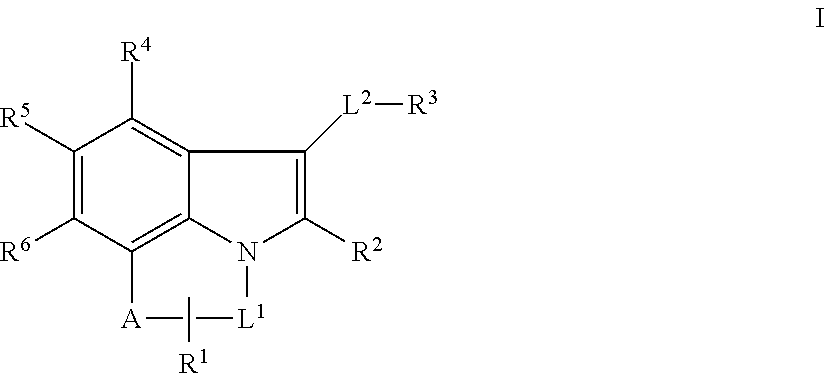Tricyclic indole mcl-1 inhibitors and uses thereof
a technology of indole and inhibitors, which is applied in the field of tricyclic indole mcl-1 inhibitors, can solve the problems of major treatment failure, poor prognosis of many cancers, and resistance to chemotherapy, and achieve the effects of improving the prognosis and treatment success ra
- Summary
- Abstract
- Description
- Claims
- Application Information
AI Technical Summary
Benefits of technology
Problems solved by technology
Method used
Image
Examples
example 1
Step G. Example 1
[0433]To a solution of methyl 6-(2-hydroxyethyl)-2,3-dihydro-[1,4]thiazino[2,3,4-hi]indole-5-carboxylate (50 mg, 0.18 mmol), PPh3 (71 mg, 0.27 mmol) and naphthalen-1-ol (44 mg, 0.28 mmol) in THF (1.0 mL) was added Dt-BuAD (62 mg, 0.27 mmol) at 20° C. The reaction mixture was stirred for 15 h at 20° C. To the reaction mixture was added KOH (101 mg, 10 mmol) and MeOH (1.0 mL). The reaction mixture was stirred for 2 h at 65° C. then concentrated in vacuo. The crude product was purified by reverse phase prep. HPLC (Phenomenex Gemini C18, H2O / CH3CN gradient to 95% CH3CN 0.1% TFA) to yield the title compound (43 mg, 0.11 mmol) as a light yellow solid. MS (ES) 390.1 (M+H).
example 2
Preparation of N-(methylsulfonyl)-6-(2-(naphthalen-1-yloxy)ethyl)-2,3-dihydro-[1,4]thiazino[2,3,4-hi]indole-5-carboxamide, I-2
[0434]To a solution of 6-(2-(naphthalen-1-yloxy)ethyl)-2,3-dihydro-[1,4]thiazino[2,3,4-hi]indole-5-carboxylic acid (12 mg, 0.030 mmol), methanesulfonamide (3.1 mg, 0.033 mmol) and PyBOP (19 mg, 0.036 mmol) in CH2Cl2 (1.0 mL) was added i-Pr2NEt (16 μL, 0.090 mmol) at 20° C. The reaction mixture was stirred for 1 h at 20° C. then quenched by addition of 0.5 N aq. HCl. The quenched reaction mixture was extracted with CH2Cl2 and concentrated in vacuo. The residue was purified by flash chromatography (Combi-flash Rf Hexane / EtOAc gradient 0-20%) to give the title compound (2.0 mg, 0.0043 mmol) as a white solid. MS (ES) 467.1 (M+H).
example 3
Preparation of 6-(2-(4-chloro-3,5-dimethylphenoxy)ethyl)-2,3-dihydro-[1,4]thiazino[2,3,4-hi]indole-5-carboxylic acid, I-3
[0435]The title compound was prepared (47 mg, 0.12 mmol) as a white solid according to procedures described in Example 1, Step F, using methyl 6-(2-hydroxyethyl)-2,3-dihydro-[1,4]thiazino[2,3,4-hi]indole-5-carboxylate (50 mg, 0.18 mmol) and substituting naphthalen-1-ol with 4-chloro-3,5-dimethylphenol (39 mg, 0.25 mmol). MS (ES) 402.1 (M+H); 1H NMR (400 MHz, DMSO-d6) δ 8.07 (d, J=8.0 Hz, 1H), 7.75 (d, J=7.2 Hz, 1H), 7.30 (t, J=7.7 Hz, 1H), 6.75 (s, 2H), 5.26 (dt, J=14.4, 3.8 Hz, 1H), 4.45 (ddd, J=14.9, 12.8, 2.7 Hz, 1H), 4.19-4.04 (m, 2H), 3.65-3.51 (m, 3H), 3.18 (ddd, J=14.1, 12.6, 3.9 Hz, 1H), 2.26 (s, 6H).
Example 4
Preparation of 1-(2-(naphthalen-1-yloxy)ethyl)-5,6-dihydro-4H-pyrrolo[3,2,1-ij]quinoline-2-carboxylic acid, I-4
Step A. Preparation of 1-nitroso-1,2,3,4-tetrahydroquinoline
[0436]The title compound was prepared as a white solid according to procedures d...
PUM
| Property | Measurement | Unit |
|---|---|---|
| of time | aaaaa | aaaaa |
| pH | aaaaa | aaaaa |
| emission wavelength | aaaaa | aaaaa |
Abstract
Description
Claims
Application Information
 Login to View More
Login to View More - R&D
- Intellectual Property
- Life Sciences
- Materials
- Tech Scout
- Unparalleled Data Quality
- Higher Quality Content
- 60% Fewer Hallucinations
Browse by: Latest US Patents, China's latest patents, Technical Efficacy Thesaurus, Application Domain, Technology Topic, Popular Technical Reports.
© 2025 PatSnap. All rights reserved.Legal|Privacy policy|Modern Slavery Act Transparency Statement|Sitemap|About US| Contact US: help@patsnap.com



